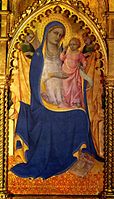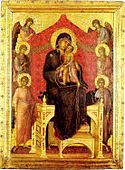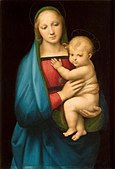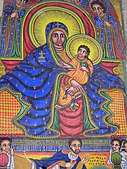Madonna (art)

| Part of a series on the |
| Mariology of the Catholic Church |
|---|
 |
|
Catholicism portal |

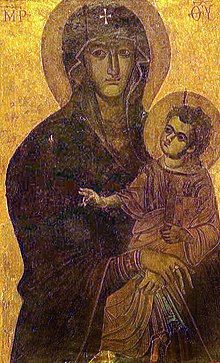

In art, a Madonna (Italian:
The term Madonna in the sense of "picture or statue of the Virgin Mary" enters English usage in the 17th century, primarily in reference to works of the
The earliest depictions of Mary date to
According to a tradition first recorded in the 8th century, and still strong in the Eastern Church, the iconography of images of Mary goes back to a portrait drawn from life by
Terminology
Liturgy depicting Mary as powerful intercessor (such as the Akathist) was brought from Greek into Latin tradition in the 8th century. The Greek title of Δεσποινα (Despoina) was adopted as Latin Domina "Lady". The medieval Italian Ma Donna pronounced [maˈdɔnna] ("My Lady") reflects Mea Domina, while Nostra Domina (δεσποινίς ἡμῶν) was adopted in French, as Nostre Dame "Our Lady".[4]
These names signal both the increased importance of the cult of the virgin and the prominence of art in service to Marian devotion during the late medieval period. During the 13th century, especially, with the increasing influence of chivalry and aristocratic culture on poetry, song and the visual arts, the Madonna is represented as the queen of Heaven, often enthroned,[5][6] such as the Ognissanti Madonna. Madonna was meant more to remind people of the theological concept which is placing such a high value on purity or virginity. This is also represented by the color of her clothing. The color blue symbolized purity, virginity, and royalty.[7][8] Ultramarine was usually reserved for only the most important commissions, such as the blue robes of the Virgin Mary in Gérard David's Virgin and Child with Female Saints.
While the Italian term Madonna paralleled English Our Lady in late medieval Marian devotion, it was imported as an
Modes of representation
There are several distinct types of representation of the Madonna.
- One type of Madonna shows Mary alone (without the child Jesus), and standing, generally glorified and with a gesture of prayer, benediction or prophesy. This type of image occurs in a number of ancient apsidal mosaics.
- Full-length standing images of the Madonna more frequently include the infant Jesus, who turns towards the viewer or raises his hand in benediction. The most famous Byzantine image, the Hodegetria was originally of this type, though most copies are at half-length. This type of image occurs frequently in sculpture and may be found in fragile ivory carvings, in limestone on the central door posts of many cathedrals, and in polychrome wooden or plaster casts in almost every Catholic Church. There are a number of famous paintings that depict the Madonna in this manner, notably the Sistine Madonna by Raphael.
- The "Madonna enthroned" is a type of image that dates from the Byzantine period and was used widely in Medieval and Renaissance times. These representations of the Madonna and Child often take the form of large altarpieces. They also occur as frescoes and apsidal mosaics. In Medieval examples the Madonna is often accompanied by angels who support the throne, or by rows of saints. In Renaissance painting, particularly High Renaissance painting, the saints may be grouped informally in a type of composition known as a Sacra conversazione.
- The Franciscan piety,[11][12] and perhaps due to Simone Martini. It spread quickly through Italy and by 1375 examples began to appear in Spain, France and Germany. It was the most popular among the styles of the early Trecento artistic period.[13]
- Half-length Madonnas are the form most frequently taken by painted icons of the Eastern Orthodox Church, where the subject matter is highly formulated so that each painting expresses one particular attribute of the "Mother of God". Half-length paintings of the Madonna and Child are also common in Italian Renaissance painting, particularly in Venice.
- The seated "Madonna and Child" is a style of image that became particularly popular during the 15th century in Passion of Christ.
- The "Adoring Madonna" is a type popular during the Renaissance. These images, usually small and intended for personal devotion, show Mary kneeling in adoration of the Christ Child. Many such images were produced in glazed terracotta as well as paint. Examples include, Madonna Adoring the Sleeping Christ Child and Madonna Adoring the Child with Five Angels (Botticelli).
- The Nursing Madonna, Virgo Lactans, or Madonna Lactans, is an iconography of the Madonna and Child in which the Virgin Mary is shown breastfeeding the infant Jesus. Examples include Leonardo da Vinci's Madonna Litta.
- The iconography of the Woman of the Apocalypse is applied to Marian portraiture in a variety of ways over time, depending on the interpretation of the relevant Biblical passage.[14]
- Hodegetria, or Virgin Hodegetria, is an iconographic depiction of the Theotokos (Virgin Mary) holding the Child Jesus at her side while pointing to him as the source of salvation for humankind. In the Western Church this type of icon is sometimes called Our Lady of the Way.
- Eleusa icon, the Eleusa (or Eleousa; Greek: Ἐλεούσα – tenderness or showing mercy) is a type of depiction of the Virgin Mary in icons in which the Christ Child is nestled against her cheek. In the Western Church the type is often known as the Virgin of Tenderness.
- The Rest on the Flight into Egypt is a subject in Christian art showing Mary, Joseph, and the infant Jesus resting during their flight into Egypt. The Holy Family is normally shown in a landscape. Examples include Rest on the Flight into Egypt (Caravaggio), and they often depict Virgo Lactans.
- The term Black Madonna or Black Virgin tends to refer to statues or paintings in Western Christendom of the Blessed Virgin Mary and the Infant Jesus, where both figures are depicted as black. The Black Madonna can be found both in Catholic and Orthodox countries, and may or may not be related to liberation theology.
- Mary in Islam, as Maryam (Mary) is one of the most honored figures in Islamic theology she is exempt from aniconism in Islam.
- Girlhood of Mary, is iconography that features the Virgin Mary as a child, often learning needlework, and examples include The Girlhood of Mary Virgin, by artist Dante Gabriel Rossetti, which is of note that Mary is the obvious central figure.
- the Annunciation to the Blessed Virgin Mary, is iconography showing the announcement by the angel Gabriel to Mary that she would conceive and bear a son through a virgin birth. Examples include Ecce Ancilla Domini.
- Death of the Virgin, Assumption of the Virgin Mary in art, Coronation of the Virgin although doctrine avoids stating whether Mary was alive or dead when she was bodily taken up to Heaven, she is normally shown in art as alive. Depicting the Coronation of Mary as Queen of the Heavens by her son, Jesus Christ, sometimes combined with the Assumption of Mary, is a tradition known since the 12th century. They often depict birds, as an appropriate image of God as the Holy Spirit.
- Presentation of Jesus at the Templeand includes other Saints in the image.
- Marian apparition the Nuestra Señora de Guadalupe is the most-visited Catholic shrine in the world, and the venerated icon has a sunburst of straight and wavy gold rays alternate while projecting behind the Virgin and are enclosed within a mandorla.
History

The earliest representation of the Madonna and Child may be the wall painting in the Catacomb of Priscilla, Rome, in which the seated Madonna suckles the Child, who turns his head to gaze at the spectator.[15]
The earliest consistent representations of Mother and Child were developed in the Eastern Empire, where despite an
In the West, hieratic Byzantine models were closely followed in the Early Middle Ages, but with the increased importance of the cult of the Virgin in the 12th and 13th centuries a wide variety of types developed to satisfy a flood of more intensely personal forms of piety. In the usual Gothic and Renaissance formulas the
Late Gothic sculptures of the Virgin and Child may show a standing virgin with the child in her arms. Iconography varies between public images and private images supplied on a smaller scale and meant for personal devotion in the chamber: the Virgin suckling the Child (such as the Madonna Litta) is an image largely confined to private devotional icons.
Early images
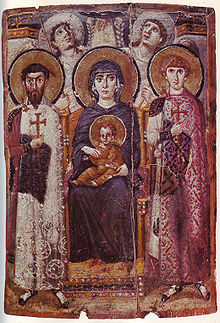
There was a great expansion of the
By the next century the iconic depiction of the Virgin enthroned carrying the infant Christ was established, as in the example from the only group of icons surviving from this period, at Saint Catherine's Monastery in Egypt. This type of depiction, with subtly changing differences of emphasis, has remained the mainstay of depictions of Mary to the present day. The image at Mount Sinai succeeds in combining two aspects of Mary described in the Magnificat, her humility and her exaltation above other humans, and has the Hand of God above, up to which the archangels look. An early icon of the Virgin as queen is in the church of Santa Maria in Trastevere in Rome, datable to 705–707 by the kneeling figure of Pope John VII, a notable promoter of the cult of the Virgin, to whom the infant Christ reaches his hand. This type was long confined to Rome. The roughly half-dozen varied icons of the Virgin and Child in Rome from the 6th–8th century form the majority of the representations surviving from this period; "isolated images of the Madonna and Child ... are so common ... to the present day in Catholic and Orthodox tradition, that it is difficult to recover a sense of the novelty of such images in the early Middle Ages, at least in western Europe".[18]
At this period the
The earliest surviving image in a Western
The Madonna of humility by Domenico di Bartolo, 1433, is considered one of the most innovative devotional images from the early Renaissance.[20]
Byzantine influence on the West
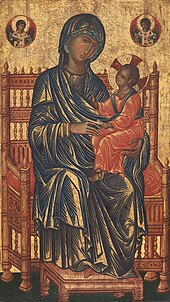
Very few early images of the Virgin Mary survive, though the depiction of the Madonna has roots in ancient pictorial and sculptural traditions that informed the earliest Christian communities throughout Europe, Northern Africa and the Middle East. Important to Italian tradition are
While theft is one way that Byzantine images made their way West to Italy, the relationship between Byzantine icons and Italian images of the Madonna is far more rich and complicated. Byzantine art played a long, critical role in Western Europe, especially when Byzantine territories included parts of Eastern Europe, Greece and much of Italy itself. Byzantine manuscripts, ivories, gold, silver and
However, what is most relevant to the Byzantine heritage of the Madonna is twofold. First, the earliest surviving independent images of the Virgin Mary are found in Rome, the center of Christianity in the medieval West. One is a valued possession of Santa Maria in Trastevere, one of the many Roman churches dedicated to the Virgin Mary. Another, a splintered, repainted ghost of its former self, is venerated at the Pantheon, that great architectural wonder of the Ancient Roman Empire, that was rededicated to Mary as an expression of the Church's triumph. Both evoke Byzantine tradition in terms of their medium, that is, the technique and materials of the paintings, in that they were originally painted in tempera (egg yolk and ground pigments) on wooden panels. In this respect, they share the Ancient Roman heritage of Byzantine icons. Second, they share iconography, or subject matter. Each image stresses the maternal role that Mary plays, representing her in relationship to her infant son. It is difficult to gauge the dates of the cluster of these earlier images, however, they seem to be primarily works of the 7th and 8th centuries.
Later medieval period
It was not until the revival of monumental
This is the case of one of the most famous, innovative and monumental works that Duccio executed for the Laudesi at Santa Maria Novella in Florence. Often the scale of the work indicates a great deal about its original function. Often referred to as the Rucellia Madonna (c. 1285), the panel painting towers over the spectator, offering a visual focus for members of the Laudesi confraternity to gather before it as they sang praises to the image. Duccio made an even grander image of the Madonna enthroned for the high altar of the cathedral of Siena, his home town. Known as the Maesta (1308–1311), the image represents the pair as the center of a densely populated court in the central part of a complexly carpentered work that lifts the court upon a predella (pedestal of altarpiece) of narrative scenes and standing figures of prophets and saints. In turn, a modestly scaled image of the Madonna as a half-length figure holding her son in a memorably intimate depiction, is to be found in the National Gallery of London. This is clearly made for the private devotion of a Christian wealthy enough to hire one of the most important Italian artists of his day.
The privileged owner need not go to Church to say his prayers or plead for salvation; all he or she had to do was open the shutters of the tabernacle in an act of private revelation. Duccio and his contemporaries inherited early pictorial conventions that were maintained, in part, to tie their own works to the authority of tradition.
Despite all of the innovations of painters of the Madonna during the 13th and 14th centuries, Mary can usually be recognized by virtue of her attire. Customarily when she is represented as a youthful mother of her newborn child, she wears a deeply saturated blue mantle over a red garment. This mantle typically covers her head, where sometimes, one might see a linen, or later, transparent silk veil. She holds the Christ Child, or Baby Jesus, who shares her halo as well as her regal bearing. Often her gaze is directed out at the viewer, serving as an intercessor, or
While the focus of this entry currently stresses the depiction of the Madonna in panel painting, her image also appears in mural decoration, whether mosaics or fresco painting on the exteriors and interior of sacred buildings. She is found high above the apse, or east end of the church where the liturgy is celebrated in the West. She is also found in sculpted form, whether small ivories for private devotion, or large sculptural reliefs and free-standing sculpture. As a participant in sacred drama, her image inspires one of the most important fresco cycles in all of Italian painting: Giotto's narrative cycle in the Arena Chapel, next to the Scrovegni family's palace in Padua. This program dates to the first decade of the 14th century.
Italian artists of the 15th century onward are indebted to traditions established in the 13th and 14th centuries in their representation of the Madonna.
-
Rest on The Flight into Egypt, c. 1510,[21] by Gerard David, depicts a close, intimate moment of tenderness where she only has eyes for the Child.
-
Lorenzo Monaco, Florence, c. 1410
Renaissance
While the 15th and 16th centuries were a time when Italian painters expanded their repertoire to include historical events, independent portraits and mythological subject matter, Christianity retained a strong hold on their careers. Most works of art from this era are sacred. While the range of religious subject matter included subjects from the Old Testament and images of saints whose cults date after the codification of the Bible, the Madonna remained a dominant subject in the iconography of the Renaissance.
Some of the most eminent 16th-century Italian painters to turn to this subject were
The subject retaining the greatest power on all of these men remained the maternal bond, even though other subjects, especially the
-
The MadonnaHortus Conclusus by an anonymouspainter
-
Madonna, c. 1484
Modern images
In some European countries, such as Germany, Italy and Poland sculptures of the Madonna are found on the outside of city houses and buildings, or along the roads in small enclosures.
In Germany, such a statue placed on the outside of a building is called a Hausmadonna. Some date back to the Middle Ages, while some are still being made today. Usually found on the level of the second floor or higher, and often on the corner of a house, such sculptures were found in great numbers in many cities; Mainz, for instance, was supposed to have had more than 200 of them before World War II.[23] The variety in such statues is as great as in other Madonna images; one finds Madonnas holding grapes (in reference to the Song of Songs 1:14, translated as "My lover is to me a cluster of henna blossoms" in the NIV), "immaculate" Madonnas in pure, perfect white without child or accessories, and Madonnas with roses symbolizing her life determined by the mysteries of faith.[24]
In Italy, the roadside Madonna is a common sight both on the side of buildings and along roads in small enclosures. These are expected to bring spiritual relief to people who pass them.[25] Some Madonnas statues are placed around Italian towns and villages as a matter of protection, or as a commemoration of a reported miracle.[26]
In the 1920s, the
Throughout his life, the painter Ray Martìn Abeyta created works inspired by the Cusco School style of Madonna painting, creating a hybrid of traditional and contemporary Latino subject matter representing the colonialist encounters between Europeans and Mesoamericans.[28][29]
In 2015 iconographer Mark Dukes created the icon
Islamic view

The first important encounter between
The
Representations in the Art History of the Indian Subcontinent
In the art history of the Indian subcontinent there are striking similarities found in between the images of Madonna and Christ Child, and Yashoda or Devaki and Krishna, as both the Hindu and the Christian figures of the "eternal child"[35] are shown cuddled warmly on the laps of their mother.[36]
There also exists a temple in Goa, the Shree Devakikrishna Temple at Marcel, where seeing the idol of Krishna-Devaki, the Portuguese had not decimated the temple, for it had reminded them of Virgin Mary-Jesus.[37]
"An impressive idol of Devaki, carrying the infant lord on her waist, stands at the inner sanctum of the temple. The image is unusual because while there exists a plethora of temples in the country dedicated to Krishna, there is no image of Devaki".[36][37] Historian Anant Dhume, in his book 'The Cultural History of Goa from 10,000 BC to 1352 AD', compares the idol with the image of Madonna and the Christ child because of the similarities.[38]
In the book, Dhume elaborates: "However, the idol of Devkikrishna originally of Chodan Island, Tiswadi taluka transferred at the time of molestation by the Christian missionaries to Mashela (Marcela in Portuguese) hamlet of Orgaon village, Ponda taluka, is interesting ... History says that Vasco da Gama in his old age was appointed Vice-Roy of all colonies of the Far East as a gesture of honour. One day, he visited Chodan Island. When he saw this idol through the main doorway, he immediately saluted the image and went on his knees, considering it the image of Mother Mary, with baby Jesus ..."[38]
During the Portuguese reign in Goa starting from the 16th Century, the Indo-Portuguese ivory statuettes made, reflected such similarities.[39] "The Portuguese had settled with the aim to dominate the spice trade and spread their Christian faith, and these small, portable ivory statues would embellish the church altars and Goan homes, and were also transported abroad serving to fulfil their later project. These figurines were carved by the Indian artists under the guidance of the Jesuits".[36] Art historian Gauvin Alexander Bailey notes that the Jesuit art commissions "were . . . a partnership in which the artists' own interpretations of sacred art were encouraged and fostered."[39] The Jesuits sourced small paintings, prints and sculptures from Europe for the Indian sculptors to use as reference, and the indigenous artists used their own traditions for fashioning such figures. One of the most brilliant example of this syncretic form is the figure called the Good Shepherd Rockery (also known as the Good Shepherd Mount or Bom Pastor) which "displays the coming together of cultures in both its iconography and its features, encapsulating how Goan sculptors created images of the divine that are Catholic, European, and South Asian".[36][39] The child form of Christ in this figure, with round face and smooth skin were perhaps drawn from sculptures of baby Krishna.[40][39][36]
Whereas, in Bengal, the Chore Bagan Art Studio, the Kansaripara Art Studio and the Calcutta Art Studio, produced homegrown prints around the second-half of the nineteenth century. These artists, were influenced by the various depictions of Christ in the European prints which had infiltrated the market of the time. And perhaps the closest connection they could draw was between the child Christ and Krishna.[41] Jyotindra Jain comments: "... the Chore Bagan Art Studio published a popular picture, titled Birth Of Krishna, which was almost entirely based on popular prints of The Birth Of Jesus Christ, to the extent that the presence of three wise men of the East was also literally imitated in this work."[41]
Artists such as Jamini Roy also adopted this image, and Jesus and Mary would feature in the canvases of Tyeb Mehta, Krishnen Khanna, Madhvi Parekh and others in ways that provide a commentary on, and glimpse of the Indian social scene.[41] Churches in India, such as Tamil Nadu's Sanctuary of Our Lady of Vailankanni which was deemed a basilica by the Roman Catholic Church in 1962, similarly housed idols of Mary clad in a traditional saree.[41] "These remain examples of how in art and in faith traditions merge, so do symbols and images, giving birth to syncretic cultures that testify the ravages of communal hate, man-made differences and orthodox interpretations".[36] Nirendranath Chakraborty, one of the finest modern poets of Bengal wrote, taking forward this imagery of the mother and the child, wrote a famous poem entitled "Kolkatar Jishu" (The Jesus of Calcutta).[42]
The everlasting tenderness of the mother-child figure, of motherhood and the unconditional bond of love and warmth that this relationship holds, "that the Christ child on Madonna's lap signifies and is reverberated in the image of Krishna-Yashoda or Devaki, is perhaps what marks the culture of love",[36] and justifies the various interpretations of this symbol in art and poetry found across the subcontinent.
Notable types and individual works

There are a large number of articles on individual works of various sorts in Category:Virgin Mary in art and its sub-category. See also the incomplete List of depictions of the Virgin and Child. The term "Madonna" is often applied to representations of Mary that were not created by Italians. A small selection of examples include:
- Golden Madonna of Essen, the earliest large-scale sculptural example in Western Europe and a precedent for the polychrome wooden processional sculptures of Romanesque France, a type known as Throne of Wisdom
- Madonna of humility, depicting a Madonna sitting on the ground, or low cushions
- Madonna and Child, a painting by Duccio di Buoninsegna, from around the year 1300
- The Black Madonna of Częstochowa(Czarna Madonna or Matka Boska Częstochowska in Polish) icon, which was, according to legend, painted by St. Luke the Evangelist on a cypress table top from the house of the Holy Family
- Madonna and Child with Flowers, possibly one of two works begun by Leonardo da Vinci
- Madonna Eleusa(of tenderness) has been depicted both in the Eastern and Western churches.
- Madonna of the Steps, a relief by Michelangelo
- Madonna della seggiola, by Raphael
- Madonna with the Long Neck, by Parmigianino
- Dalícreated in 1949 and 1950
Paintings
- Madonna in Art
-
Madonna in Mandorla, Wolfgang Sauber, 12th century
-
Madonna and Angels, Duccio, 1282
-
Our Mother of Perpetual Help, probably an early Cretan work, 13th or 14th century. A very popular Catholic image, which was certainly in Rome by 1499.
-
Mary and the child depicted as a hodegetria. Tesselated icon in monumental style, early 13th century. Saint Catherine's Monastery in the Sinai, Egypt.
-
Madonna in the rose-garden by Stefan Lochner, 1448
-
Burgundy, c. 1435
-
Madonna del Granduca, Raphael, 1505
-
Madonna of the Pinks, Raphael, probably before 1507
-
Madonna and Child Surrounded by Angels by Quentin Matsys, c. 1509
-
Maria Hilf by Lucas Cranach the Elder, c. 1530
-
Virgin and Child with Angels and Saints, Felice Torelli, 17th century
-
A fresco of a black Madonna and Jesus at theAxum, Ethiopia
Statues
-
Egyptian ivory carving, one of the earliest examples of what in later Byzantine times was called Eleousa, or "Virgin of Tenderness". 7th century.
-
Golden Madonna of Essen, c. 980
-
Presbyter Martinus: Madonna as Seat of Wisdom, Italy, 1199
-
Statue outside Moscow's New Tretyakov Gallery
-
Statue Notre-Dame Cathedral Basilica, Ottawa, Ontario, Canada
-
A roadside Madonna in Ocieka, Poland
-
A roadside Madonna alcove in Friuli, Italy
-
La Conquistadora, Santa Fe, New Mexico, pre-1625
Manuscripts and covers
-
An ivory cover of the Codex Aureus of Lorsch, Germany, c. 800
-
Svanhild Evangeliary, an Illuminated manuscript from Essen, 1058–1085
-
The Madonna and child in Musa va 'Uj, a manuscript painting from Iran or Iraq, 1460s
See also
- Christian art
- Art in Roman Catholicism
- Mary (mother of Jesus)
- Roman Catholic Marian art
- Pietà
- Nursing Madonna
- Life-giving Spring
- Eleusa icon
- Theotokos
- Icon of the Hodegetria
- Our Lady of Guadalupe
- La Conquistadora
- Nativity of Jesus in art
Notes
- Bramante reveal that Raphael told him that he discovered how to paint his Madonnas in a visionary dream he had after praying to the Virgin.[22]
References
- ISBN 0-87779-044-2p. 696.
- ISBN 0-9712981-9-Xp. 11
- ISBN 1-57918-355-7 [page needed]
- ^ Johannes Schneider, Virgo Ecclesia Facta, 2004, p. 74 Archived 2022-12-30 at the Wayback Machine. Michael O'Carroll, Theotokos: A Theological Encyclopedia of the Blessed Virgin Mary, 2000, p. 127 Archived 2022-12-30 at the Wayback Machine.
- ^ "Madonna and Child on a Curved Throne".
- ^ "Madonna and Child Enthroned with Four Saints".
- ^ "The History of the Color Blue: From Ancient Egypt to the Latest Scientific Discoveries". 12 February 2018.
- ^ "Why Jesus and Mary Always Wear Red and Blue in Art History". 19 December 2018.
- ^ "Madonna of Vladimir" e.g. in Hans Belting, Edmund Jephcott; Edmund Jephcott (trans.) Likeness and Presence: A History of the Image Before the Era of Art, University of Chicago Press, 1996, p. 289.
- ISBN 0-313-24658-0p. 174
- ISBN 0-06-433317-5p. 223
- ^ Iconography of Christian Art by Gertrud Schiller, 1971 ASIN B0023VMZMA p. 112
- ISBN 0-691-00312-2pp. 132–133
- ^ Roten, Johann. "Crescent Moon: Meaning : University of Dayton, Ohio". udayton.edu.
- ^ Victor Lasareff, "Studies in the Iconography of the Virgin" The Art Bulletin 20.1 (March 1938, pp. 26–65 [pp. 27f]).
- ^ m. Mundell, "Monophysite church decoration" Iconoclasm (Birmingham) 1977, p. 72.
- Basilica di San Clemente, Rome: see John L. Osborne, "Early Medieval Painting in San Clemente, Rome: The Madonna and Child in the Niche" Gesta 20.2 (1981), pp. 299–310.
- ISBN 978-0-19-284243-5
- JSTOR 3048928.
- ISBN 0-7546-0689-9 p. 15 [1]
- ^ "National Gallery of Art, Washington D.C." Archived from the original on 2014-07-26. Retrieved 2014-07-08.
- ^ Salmi, Mario; Becherucci, Luisa; Marabottini, Alessandro; Tempesti, Anna Forlani; Marchini, Giuseppe; Becatti, Giovanni; Castagnoli, Ferdinando; Golzio, Vincenzo (1969). The Complete Work of Raphael. New York: Reynal and Co., William Morrow and Company. p. 622.
- ISBN 978-3-937782-70-6.
- ^ Anne-Madeleine Plum, "Kreuzzepter-Madonna--Zypertraube ind fruchtbringende Rede" and "Maria, Geheimnisvolle Rose", in Wöhrlin, Mainzer Hausmadonnen, pp. 49–54, 55–57.
- ISBN 1-58391-913-9p. 68
- ISBN 0-9743552-4-0p. 219
- ^ "Madonna of the Trail". Archived from the original on 2011-06-06. Retrieved 2009-12-09.
- ^ Williams, Stephen P. (August 5, 2007). "The Art Is Striking, and So Are the Cars". The New York Times. Retrieved 9 April 2019.
- ^ Roberts, Kathaleen (June 29, 2014). "NM History Museum unveils rare colonial paintings of Mary". Albuquerque Journal. Retrieved 9 April 2019.
- ^ Prayer and Devotion Archived 2020-09-30 at the Wayback Machine
- ISBN 978-0196360331. Retrieved 2011-12-08.
Quraysh had put pictures in the Ka'ba including two of Jesus son of Mary and Mary (on both of whom be peace!). ... The apostle ordered that the pictures should be erased except those of Jesus and Mary.
- ISBN 978-0804781817.
When Muhammad ordered his men to cleanse the Kaaba of the statues and pictures displayed there, he spared the paintings of the Virgin and Child and of Abraham.
- ISBN 978-1587680298.
- ^ Martin Lings, Muhammad: His Life Based on the Earliest Source (Rochester: Inner Traditions, 1987), pp. 17, 300.
- ^ "Rabindranath Tagore - Verses - Fireflies - 26 (the child ever dwells)". www.tagoreweb.in. Retrieved 2023-04-06.
- ^ a b c d e f g enrouteI (2022-12-23). "On the Mother's Lap". Enroute Indian History. Retrieved 2023-04-06.
- ^ ISSN 0971-8257. Retrieved 2023-04-06.
- ^ OCLC 693684216.
- ^ a b c d "Christian art in India: Indo-Portuguese ivory statuettes (article)". Khan Academy. Retrieved 2023-04-06.
- ISBN 9781315456058.
- ^ a b c d "The Indian Pieta". Mintlounge. 2019-12-23. Retrieved 2023-04-06.
- ^ "বাংলার কবিতা - কলকাতার যীশুনীরেন্দ্রনাথ চক্রবর্তী". banglarkobita.com. Retrieved 2023-04-06.
External links
- Metropolitan Museum: The Virgin Mary in the Middle Ages
- The Madonna in Art at Estelle M. Hurll(First printed 1897)


